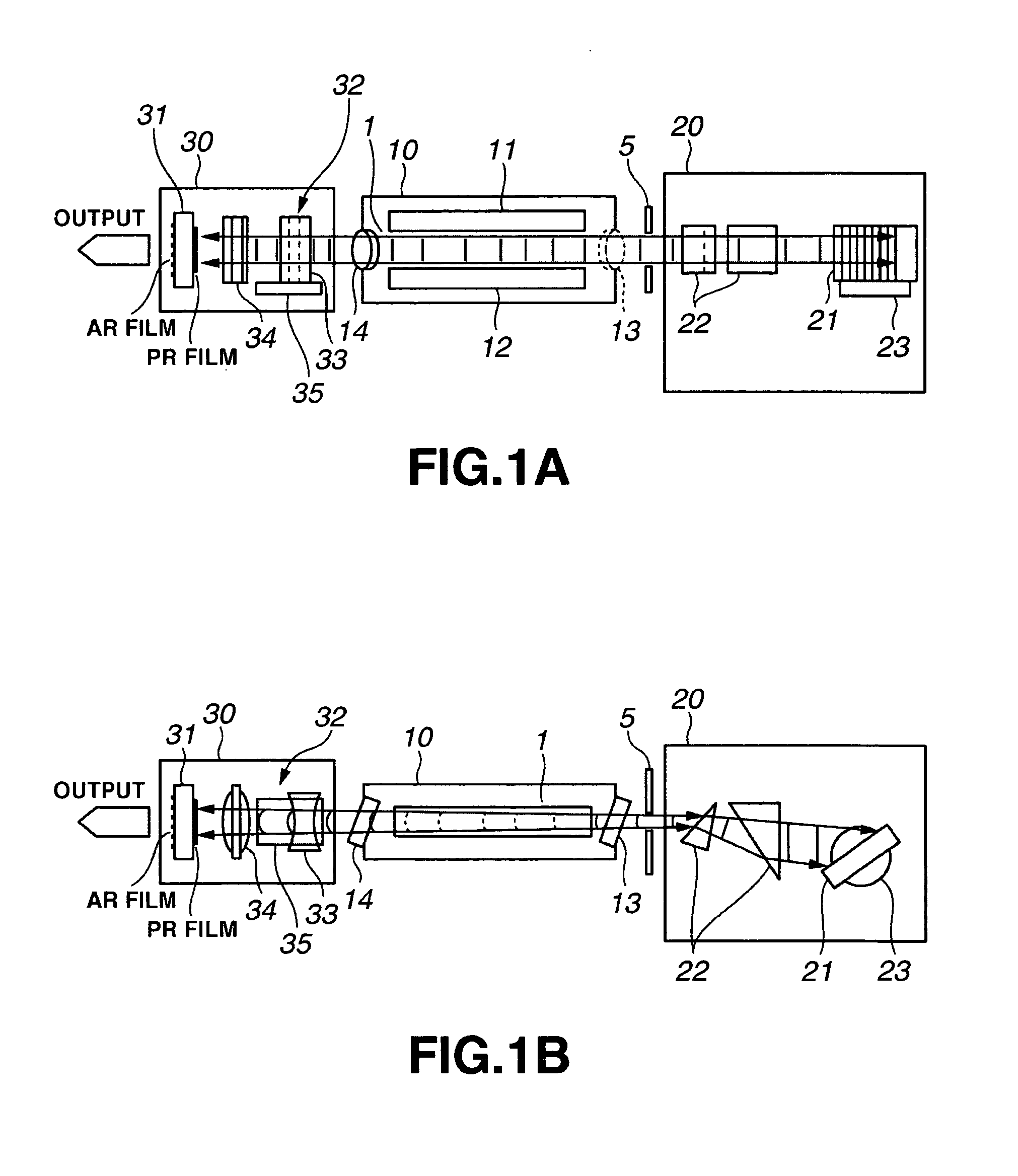Line narrowed laser apparatus
a laser apparatus and narrowing technology, applied in laser details, excitation process/apparatus, active medium materials, etc., can solve the problems of deteriorating quality of integrated circuits, affecting the efficiency of laser equipment,
- Summary
- Abstract
- Description
- Claims
- Application Information
AI Technical Summary
Benefits of technology
Problems solved by technology
Method used
Image
Examples
first embodiment
[First Embodiment]
[0075]FIG. 1A is a top view of the configuration of a line narrowed laser apparatus in accordance with a first embodiment. FIG. 1B is a side elevational view of the configuration of the line narrowed laser apparatus having a wavefront corrector.
[0076] As shown in FIGS. 1A and 1B, an ordinary line narrowing module 20 is disposed on the rear side (right side in the drawing) of a laser chamber 10, and a wavefront adjusting module 30 is disposed on the front side (left side in the drawing) thereof.
[0077] A pair of discharge electrodes 11 and 12, which are spaced apart a predetermined distance, whose longitudinal directions are parallel, and whose discharge surfaces are opposed to each other, are provided inside the laser chamber 10. Further, windows 13 and 14 are provided at a laser light outputting portion on the optical axis of the laser light in the laser chamber 10. The windows 13 and 14 are formed of a material which is permeable to the laser light, such as CaF2...
second embodiment
[Second Embodiment]
[0111] In this embodiment, a description will be given of a form different from the first embodiment.
[0112]FIG. 6 is a side elevational view of the configuration of the line narrowed laser apparatus in accordance with a second embodiment. The difference between the first embodiment and the second embodiment lies in the internal configuration of the wavefront adjusting module.
[0113] As shown in FIG. 6, the wavefront adjusting module 30 has the wavefront corrector 32. The wavefront corrector 32 has a cylindrical convex lens 37, a cylindrical concave lens 36, and the linear stage 35 for holding the concave lens 36. The convex lens 37 has one surface processed into a flat shape and the other surface processed into a cylindrical shape. Meanwhile, the concave lens 36 has one surface processed into a flat shape and the other surface processed into a cylindrical shape. The convex lens 37 and the concave lens 36 are arranged on the optical axis such that the cylindrical ...
third embodiment
[Third Embodiment]
[0126] In this embodiment, a description will be given of still another form different from the first embodiment.
[0127]FIG. 7 is a side elevational view of the configuration of the line narrowed laser apparatus in accordance with a third embodiment. FIG. 8 shows a cross section taken along line A—A in FIG. 7. The difference between the first embodiment and the third embodiment lies in the configuration of the front side of the laser.
[0128] As shown in FIG. 7, a deformable mirror 70, which is an end mirror, is disposed on the front side of the laser chamber 10. In this embodiment, the laser wavefront is varied (modified) by shaping the configuration of the total reflection surface of the deformable mirror 70.
[0129] The laser resonator is formed by the grating 21 Littrow-configured on the rear side of the laser chamber 10 and the deformable mirror 70 disposed on the front side. A 45-degree incident beam splitter 71 is disposed on the optical path between the laser...
PUM
 Login to View More
Login to View More Abstract
Description
Claims
Application Information
 Login to View More
Login to View More - R&D
- Intellectual Property
- Life Sciences
- Materials
- Tech Scout
- Unparalleled Data Quality
- Higher Quality Content
- 60% Fewer Hallucinations
Browse by: Latest US Patents, China's latest patents, Technical Efficacy Thesaurus, Application Domain, Technology Topic, Popular Technical Reports.
© 2025 PatSnap. All rights reserved.Legal|Privacy policy|Modern Slavery Act Transparency Statement|Sitemap|About US| Contact US: help@patsnap.com



